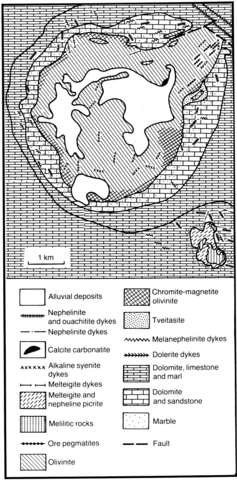stripes
Bor-Uryakh is situated 40 km south of the Dalbykha group of intrusions at the intersection of the Maimecha-Kotui and Ambardach faults. It was discovered in 1943-4 by Yu.M. Sheinman and has been studied at different times by E.L. Butakova, L.S. Egorov, A.G. Zhabin, Yu.R. Vasiliev and V.V. Zolotuchin. The complex has a pear-shaped form and occupies an area of 18.5 km2. The country rocks are dolomites, sandstones, marls, siltstones and marbles. It is an olivinite stock of simple structure with an outer zone of dunite. Throughout the intrusion there are numerous dykes and veins which are mainly ore olivinite pegmatites and peralkaline syenites, with more rarely jacupirangite pegmatites, melteigites and calcite carbonatites. Mineralogically the rocks comprise combinations of olivine, titanomagnetite and highly variable modal proportions of clinopyroxene, perovskite, chromite, phlogopite, calcite, clinohumite and spinel. In some places the content of ore minerals (titanomagnetite, perovskite and chromite) increases from 5-10% up to 20-25% and even up to 50%. 'Quenched' more fine-grained olivinites, which are enriched in magnetite and chromite, are found in the marginal zones of the complex.
BUTAKOVA, E.L. and EGOROV, L.S. 1962. The Meimecha-Kotui complex of formations of alkaline and ultrabasic rocks. In Petrography of Eastern Siberia. 1: 417-589. Izd-vo AN SSSR, Moscow.
EGOROV, L.S. 1969. The melilite rocks of the Maimecha-Kotui province. Nedra, Leningrad. 247 pp.
EGOROV, L.S. 1991. Ijolite carbonatite plutonism (case history of the Maimecha-Kotui complexes northern Siberia). Nedra, Leningrad. 260 pp.
Sheinman et al., 1961; Vasiliev and Zolotuchin, 1975.

